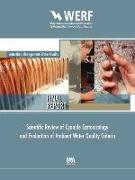- Start
- Scientific Review of Cyanide Ecotoxicology and Evaluation of Ambient Water Quality Criteria
Scientific Review of Cyanide Ecotoxicology and Evaluation of Ambient Water Quality Criteria
Angebote / Angebote:
The USEPA's ambient water quality criteria (AWQC) for cyanide were developed in 1984. Recently, however, concerns have arisen that the AWQC for cyanide have been problematic to implement and may not accurately reflect either the toxic forms or bioavailable concentrations of cyanide in water, sediments, and tissues of aquatic organisms. Also, the cyanide criteria typically have been implemented based on total cyanide concentrations rather than the free cyanide concentrations that formed the basis of the criteria calculations. New knowledge on cyanide toxicity, cyanide speciation and its measurement, and the relative toxicity of bioavailable cyanide species suggested that a re-evaluation of the aquatic toxicity data and chemistry that serve as the basis of the current national criteria is warranted. In response to these concerns, studies sponsored by the Water Environment Research Foundation (WERF) evaluated the formation and fate of cyanide in municipal wastewater effluents. Kavanaugh et al. (2003) evaluated the reliability of several analytical methods for measurement of cyanide species at low (ppb) concentrations, along with studies to evaluate the sources, transport, and fate of cyanide species in wastewater treatment plants (WWTPs) and receiving waters. Results indicated that potentially toxic forms of cyanide can be generated in WWTPs from several chemical processes, including dissociation of thiocyanate by chlorination or UV disinfection, chlorination in the presence of residual ammonia, nitrosation, and photolysis of ferrocyanate. Models were developed for predicting the fate of these compounds in surface waters downstream of WWTP effluents to establish where organisms might be most at risk from cyanide exposure. While implementation of these results could assist in the development of site-specific water quality standards for cyanide, a more thorough update to the National AWQC was warranted to apply our more current scientific understanding of cyanide toxicology to the derivation of aquatic life criteria. The present study was therefore undertaken to review and update knowledge of the aquatic toxicity of cyanide, and to develop recommended updates to the existing national AWQC to enhance the scientific basis of the concentrations and chemical forms of cyanide specified for protection of aquatic organisms. This update was conducted according to USEPA guidance for derivation of AWQC for protection of aquatic life, and is based both on an extensive literature review and on new toxicity studies that fill key data gaps. This re-evaluation of cyanide criteria also includes consideration of impacts on benthic (sediment) organisms, wildlife that consume aquatic biota, and possible effects to threatened and endangered species to ensure that revised criteria are adequately protective of the entire aquatic ecosystem.
Folgt in ca. 15 Arbeitstagen
